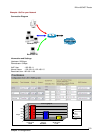
Billion 800VGT Router
Sometime
your
customers
or
friends
may
upload
their
files
to
your
FTP
server
and
that
will
saturate
your
downstream
bandwidth.
The
settings
below
will
help
you
to
limit
bandwidth
for
such
a
application
that
needs
restriction.
Virtual
Server
(known
as
Port
Forwarding)
In
TCP/IP
and
UDP
networks,
a
port
is
a
16-bit
number
used
to
identify
which
application
program
incoming
connections
should
be
delivered
to.
Some
ports
have
numbers
that
are
pre-assigned
to
them
by
the
IANA
(the
Internet
Assigned
Numbers
Authority),
and
these
are
referred
to
as
“well-known
ports”.
Servers
follow
the
well-known
port
assignments
so
clients
can
locate
them.
If
you
wish
to
run
a
server,
or
any
application
(e.g.
Peer-to-peer/P2P
software
such
as
instant
messaging
applications
and
P2P
file-sharing
applications)
on
your
network
that
can
be
accessed
from
the
WAN
(i.e.
from
machines
on
the
Internet
that
are
outside
your
local
network,
and
you
are
using
NAT
(Network
Address
Translation),
then
you
will
need
to
configure
your
router
to
forward
these
incoming
connection
attempts
using
specific
ports
to
the
computer
on
your
network
that
is
running
the
application/server.
You
will
also
need
to
use
port
forwarding
if
you
want
to
host
an
online
game
server.
The
reason
for
this
is
that
when
using
NAT,
your
publicly
accessible
IP
address
will
be
used
by
and
point
to
your
router,
which
then
needs
to
deliver
all
traffic
to
the
private
IP
addresses
used
by
your
PCs.
Please
see
the
WAN
configuration
section
of
this
manual
for
more
information
on
NAT.
The
device
can
be
configured
as
a
virtual
server
so
that
remote
users
accessing
services
such
as
Web
or
FTP
services
on
the
routers
public
(WAN)
IP
address
can
be
automatically
redirected
to
local
servers
on
the
LAN
network.
Depending
on
the
requested
service
(TCP/UDP
port
number),
the
router
redirects
the
external
service
request
to
the
appropriate
server
within
the
LAN
network
121
Chapter
4:
Configuration


















